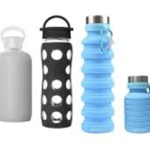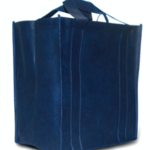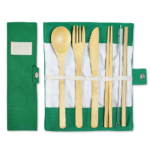Woah! Is it July already? These past few months sure seem to have ZOOMed right by. Along with the majority of you, I’ve been working from home this summer while we #FlattenTheCurve and I’ve noticed quite a few things about my home that I just didn’t before. Things like, did I always use that much Saran Wrap for leftovers? And, where did all these Ziploc bags come from? So, with these questions in mind, I sought to be more conscious of my plastic use. Luckily this month just happens to be Plastic Free July (nice timing, huh)!
If you don’t already know, Plastic Free July is a global movement dedicated to reducing our single-use plastic waste so that we can have cleaner streets, communities, and a healthy ocean. As with most things, that’s easier said than done. So how do I go about reducing my plastic use when it literally permeates all levels of our daily lives?
The first step would be to conduct a plastic audit.
You have to know how much plastic you use first before you can actually go about reducing it. Conduct an audit as I did. I took a count of some of the biggest offenders in my kitchen, bathroom, and closet and provided some potential alternatives. (Staff’s Note: Coastkeeper does not receive any proceeds from products mentioned in this blog however, we encourage you to donate to our education programs, and help us continue to spread the word on reducing plastic waste!) Let’s get started!
- Kitchen
-
-
-
-
- At-home cooking means tons of leftovers for the next day. To keep the food fresh, my family goes through a ton of plastic wrap after each meal. A sustainable alternative to all this plastic wrap could be beeswax food wraps. They’re easy to use, reusable, and are an all-natural alternative to plastic food wrap. And if you want a super-duper cheap alternative, just put a plate over your bowl. It keeps the bad stuff out and keeps your food fresh.

- At-home cooking means tons of leftovers for the next day. To keep the food fresh, my family goes through a ton of plastic wrap after each meal. A sustainable alternative to all this plastic wrap could be beeswax food wraps. They’re easy to use, reusable, and are an all-natural alternative to plastic food wrap. And if you want a super-duper cheap alternative, just put a plate over your bowl. It keeps the bad stuff out and keeps your food fresh.
-
- Looking around in drawers I noticed boxes full of plastic zipper bags. To be perfectly honest, I have no idea what we need all of these bags for since I rarely see us take these out, but they’re here and most likely thrown out after a single-use. One no-cost option would be to simply wash the bags after each use. Since they’re plastic they’ll last quite a while (like hundreds of years). If you’re willing to spend a bit of cash, Stasher Bags are also a pretty good option.
-
- What we also have a lot of in our house are plastic containers. They see some fair use and are employed for both food and miscellaneous storage. Although plastic containers are a bit cheaper, lighter, and more shatter-resistant than glass containers, the health concerns are more than enough to make the switch. Plastic containers can leach toxic chemicals into your food at high temperatures, which can have negative health impacts. So, if you’ve got any plastic containers lying around, it’s best to reserve those for nonfood items and invest in some glass containers for the kitchen.
- If you’re washing a lot of dishes like me, maybe consider reusing the bottle and refilling it with dish soap. You can buy a larger bottle of dish soap to use for refills or visit a refilling station where you can pay for the weight of the item you are purchasing. You can bring in your own container from home, like reused pasta sauce or pickle jars! Two local refilling stations in or around Orange County are Eco Now in Costa Mesa and BYO Long Beach in Long Beach.
-
Bathroom
-
-
- Hand soap is pretty similar to dish soap. Our family actually reuses the soap bottles and we just refill it with one giant tub we buy. We’ve actually been reusing one soap bottle for nearly 16 years! That’s almost as long as I’ve been alive.
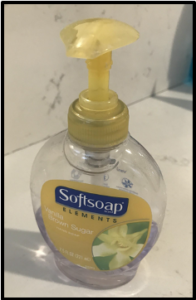
- Hand soap is pretty similar to dish soap. Our family actually reuses the soap bottles and we just refill it with one giant tub we buy. We’ve actually been reusing one soap bottle for nearly 16 years! That’s almost as long as I’ve been alive.
-
- I actually got a bit stuck with this one. Toothbrushes! I usually toss out my plastic toothbrush once the bristles on the head start to wear out, and I never really gave much thought to the number I go through in a year. I did some searching and found out about bamboo toothbrushes. They’re biodegradable, so you don’t have to feel too guilty when tossing it out. Although some come with the standard nylon bristles, many come with natural fiber bristles!
- And since we’re on the topic of dental hygiene, did you know that toothpaste and mouthwash tablets existed?!? I know I didn’t, but it turns out that these tablets are eco-friendlier due to their light compact packaging. They are also TSA approved, which is a HUGE plus in my book. I can’t even begin to count how many times I’ve held up my travel group due to a forgotten toothpaste tube buried within my bag. Another common dental product that also comes to mind is dental floss. For those of you who actually floss, buying natural silk floss is a great alternative to regular dental floss. Bite Toothpaste is a good site for monthly toothpaste tablet subscriptions and some of those previously mentioned bamboo brushes. For the floss, you can check out our buddies at Plastic Me Not. They also have some great plastic alternatives to a large number of items.
-
Closet
-
- Most of the items I found in my closet were quick-drying, workout clothes, and fast fashion oddities, worn only once or twice. Younger me didn’t understand the detrimental effects of polyester fabrics on the environment, but older me knows better now.
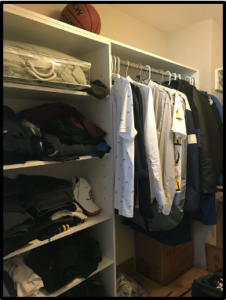 Since most of these clothes no longer fit, I decided to throw them out. But how do you do so in an environmentally friendly way? Donating or recycling your old clothes is a great option. Many donation centers welcome your old clothes, and nowadays many businesses recycle your old garments AND give you a discount on your next purchase. When purchasing new clothes, try to buy used or durable items woven with natural fibers that will last for years. Synthetic materials shed tiny microfibers in each wash that ultimately end up in the ocean.
Since most of these clothes no longer fit, I decided to throw them out. But how do you do so in an environmentally friendly way? Donating or recycling your old clothes is a great option. Many donation centers welcome your old clothes, and nowadays many businesses recycle your old garments AND give you a discount on your next purchase. When purchasing new clothes, try to buy used or durable items woven with natural fibers that will last for years. Synthetic materials shed tiny microfibers in each wash that ultimately end up in the ocean.
- Most of the items I found in my closet were quick-drying, workout clothes, and fast fashion oddities, worn only once or twice. Younger me didn’t understand the detrimental effects of polyester fabrics on the environment, but older me knows better now.
- If you’re washing your polyester fabrics, there are some preventative options to mitigate the shedding of microfibers when doing laundry. The Cora Ball is a great option that collects microfibers into a visible fuzz that can later be disposed of properly. Another portable option with a more effective filter is the Guppy Friend washing bag. It reduces microfiber shedding, protects your clothes, and filters the few fibers that actually do break. The most effective (but most costly and permanent) option is a microfiber filter such as the LINT LUV-R. It’ll stop most microfibers from bypassing its systems and is simple to clean and reuse.
-
-
-
-
This plastic audit actually took a bit longer than I expected and I found a lot more plastic in my home than I ever expected. Sadly, I had to leave out some items for the sake of length, or else this blog entry would actually be longer than all of my college applications combined.
One thing not mentioned above that finds its way into our watersheds quite often – balloon litter. Check out this awesome resource to help find alternatives for celebrations and parties. By making some small changes—such as refusing straws, using reusable utensils, finding alternatives to balloons, and using reusable shopping bags—in our daily lives, we can all make the world a more environmentally friendly place.
Have a nice Plastic Free July everyone!
